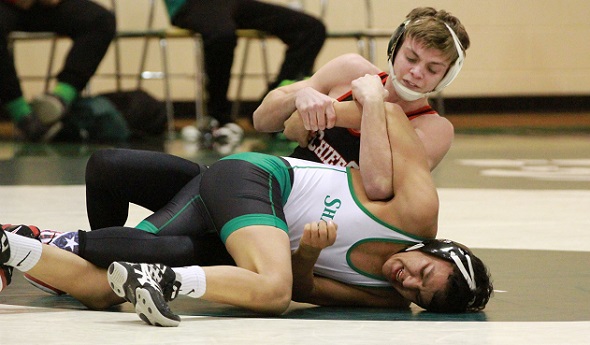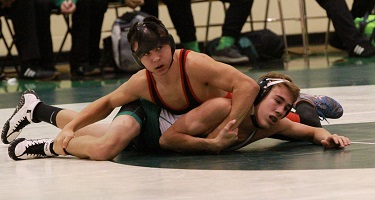
White Pigeon Emerging as D4 Hopeful
January 10, 2017
Ten years removed from a Regional Finals appearance, the White Pigeon wrestling program has awakened from its hibernation.
 The Chiefs’ 18-7 overall record isn’t particularly astonishing. But given that several losses were to bigger schools outside of the state of Michigan, including three to Indiana squads this past weekend, it’s a solid mark so far.
The Chiefs’ 18-7 overall record isn’t particularly astonishing. But given that several losses were to bigger schools outside of the state of Michigan, including three to Indiana squads this past weekend, it’s a solid mark so far.
A victory over third-ranked (in Division 4) Decatur earlier this year opened White Pigeon’s eyes as to how good it could be this winter.
“The kids’ resiliency and perseverance,” 14th-year head coach Jay Sosinski said when asked what has stood out to him this season. “It doesn’t matter to them who they’re going up against. Big or small, good or bad, they go out there and wrestle hard and give it their best. That’s all I’ve ever asked of any of my teams. They do it probably better than any team I’ve had before on a consistent basis.”
To put that statement in context, Sosinski hypes his team as often as most people stick to their New Year’s resolutions.
There’s no denying that confidence has trickled down to the individual wrestlers, four of whom are among the top-10 ranked athletes in their respective weight classes in Division 4 by MichiganGrappler.com.
Ranked No. 3 at 130 pounds, sophomore Kyle Black is 22-2 on the year and eyeing a return trip to the MHSAA Finals. He’ll likely drop down to 125 to do so. Classmate Evan Atherton is ranked No. 10 at 130 but has since moved to 125.
“It makes us feel good,” Atherton, who is 20-3, said of the high praise from Sosinski, “because they used to talk about how there used to only be three kids on the team. “I’m pretty excited about it. It pushes me harder.”
Junior Nate Weber is 21-4 and ranked No. 6 at 135. He, too, will probably move down a class by the end of the year in order to try to get back to the Palace of Auburn Hills. Meanwhile, senior Hunter Rummler, ranked No. 7 at 171, just eclipsed the 100-victory mark for his career over the weekend and is pushing toward his first Individual Finals appearance.
 Especially for the young men in the lower weights, stiffer competition is rarely found outside their own practices this year.
Especially for the young men in the lower weights, stiffer competition is rarely found outside their own practices this year.
“We do a lot of live wrestling in the room, and it sure helps to have those guys around with all the variety it brings,” Weber said. “Me, Evan and Kyle all wrestle different styles. We see all these different techniques, and it sets us up to wrestle all these other teams.”
Black had just one word to describe practice sessions: “Intense.”
The other word that came up frequently was inspiration. The source? Sosinski.
“I would never have guessed that is the answer they would have given,” Sosinski said with a laugh. “As a wrestler myself and growing up in the sport, when people get beat, either as an individual or a team, I know how that feels. They beat themselves up and are upset. Me being upset with them or screaming and yelling at them doesn’t make them feel any better.
“I believe it probably makes them feel worse and can have a negative effect. My goal is to help them reach their goals. I’m happiest when I see them reach their goals and their potential. If being more soft-spoken and more of a fatherly type figure and voice does that, and it has worked so far, that’s what I’ll continue to do.”
With only two seniors on the varsity roster, the Chiefs are undefeated in the Berrien-Cass-St. Joseph Conference. Rummler, who said reaching the century mark “hasn’t really hit me yet,” knows the strength of the team is in the lower and middle weights, which includes stalwarts Hunter Jourdan, Sebastian Castro and Carlos Castro, and feels a responsibility to hold up his end of the bargain.
For Rummler, a gifted running back and sprinter, most of the battle is mental — a fight he admits struggling with last season. Sosinski believes the senior is primed for a noteworthy finish to his career.
“He is confident,” Sosinski said. “I believe he has high goals and expectations of himself. He is confident he will meet those goals. Sometimes you need that swag, I guess. If I had to take a guess at (what’s different this year), just from knowing him for four years, it’s just his mentality.”
The same can be said for the rest of the wrestlers on the team, many of whom have sacrificed for the betterment of the squad.
“They want to be good as a team, and that’s first and foremost,” Sosinski said. “They have their own individual goals in their head, but they’re finding a way to do both.”
 Wes Morgan has reported for the Kalamazoo Gazette, ESPN and ESPNChicago.com, 247Sports and Blue & Gold Illustrated over the last 12 years and is the publisher of JoeInsider.com. He can be reached at [email protected] with story ideas for Berrien, Cass, St. Joseph and Branch counties.
Wes Morgan has reported for the Kalamazoo Gazette, ESPN and ESPNChicago.com, 247Sports and Blue & Gold Illustrated over the last 12 years and is the publisher of JoeInsider.com. He can be reached at [email protected] with story ideas for Berrien, Cass, St. Joseph and Branch counties.
PHOTOS: (Top) White Pigeon’s Kyle Black works to gain control during a match against Berrien Springs. (Middle) Evan Atherton, here working from the top, also powers the Chiefs’ strong lower weights. (Photos courtesy of Wes Morgan.)

- Boys Swim & Dive
- Wrestling
- Girls Swim & Dive
- Competitive Cheer
- Girls Bowling
- Girls Skiing
- Boys Skiing
- Girls Basketball
- Boys Basketball
- Boys Bowling
- Gymnastics
- Ice Hockey
- MHSAA News
MHSAA Winter Sports Start with Extended Basketball Schedules, New Wrestling Weights
By
Geoff Kimmerly
MHSAA.com senior editor
December 13, 2022
The addition of two games to basketball regular-season schedules and a new series of wrestling weight classes are likely the most noticeable Winter 2022-23 changes as an estimated 65,000 athletes statewide take part in 13 sports for which the Michigan High School Athletic Association sponsors postseason tournaments.
Girls gymnastics and boys ice hockey teams were able to begin practice Oct. 31, with the rest of those sports beginning in November – including also girls and boys basketball, girls and boys bowling, girls competitive cheer, girls and boys skiing, Upper Peninsula girls and boys and Lower Peninsula boys swimming & diving, and girls and boys wrestling.
A variety of changes are in effect for winter sports this season, including a several that will be noteworthy and noticeable to teams and spectators alike.
Basketball remains the most-participated winter sport for MHSAA member schools with 33,000 athletes taking part last season, and for the first time, basketball teams may play up to 22 regular-season games. This increase from the previous 20-game schedule allows more games for teams at every high school level – varsity, junior varsity and freshman.
Another significant change has been made in wrestling, as the majority of boys wrestling weight classes have been adjusted for this season in anticipation of a national change coming in 2023-24. The updated boys weight classes are 106, 113, 120, 126, 132, 138, 144, 150, 157, 165, 175, 190, 215 and 285 pounds. Only 215 and 285 remain from the previous lineup. There is also one change to girls weight classes, with the 255 class replaced by 235 to also align with national high school standards.
A series of notable changes will affect how competition takes place at the MHSAA Tournament levels. In hockey, in addition to a new classification process that spread cooperative and single-school programs evenly throughout the three playoff divisions, the MHSAA Tournament will employ two changes. The Michigan Power Ratings (MPR) will be used to seed the entire Regional round, not just the top two teams, and prior to the start of Semifinals, a seeding committee will reseed the remaining four teams in each division with the top seed in each then facing the No. 4 seed, and the No. 2 seed facing No. 3.
Bowling also will see an MHSAA Tournament change, as the Team Regional format will mirror the long-standing Team Final with teams playing eight Baker games and two regular games at both levels. And as also applied during the fall girls season, there is a new qualification process for divers seeking to advance to Lower Peninsula Boys Swimming & Diving Finals. In each of the three divisions, each Regional will be guaranteed 10 qualifiers for the Finals, with six more “floating” qualifier entries to be distributed to the Regionals that have one of the previous year’s top six returning Finals divers in their fields. If a team changes division from the previous season, any floating top-six spots are added to the six already allowed in the school’s new division.
A gymnastics rules change provides an opportunity for additional scoring during the floor exercise. A dance passage requirement was added in place of the former dance series requirement to encourage creativity and a more artistic use of dance. The dance passage requires gymnasts to include two Group 1 elements – one a leap with legs in cross or side split position, the other a superior element.
In competitive cheer, the penalty for going over the time limit in each round was adjusted to one penalty point for every second over the time limit, not to exceed 15 points. The new time limit rule is more lenient than the past penalty, which subtracted points based on ranges of time over the limit.
The 2022-23 Winter campaign culminates with postseason tournaments, as the championship schedule begins with the Upper Peninsula Girls & Boys Swimming & Diving Finals on Feb. 18 and wraps up with the Boys Basketball Finals on March 25. Here is a complete list of winter tournament dates:
Boys Basketball
Districts – March 6, 8, 10
Regionals – March 13, 15
Quarterfinals – March 21
Semifinals – March 23-24
Finals – March 25
Girls Basketball
Districts – Feb. 27, March 1, 3
Regionals – March 7, 9
Quarterfinals – March 14
Semifinals – March 16-17
Finals – March 18
Bowling
Regionals – Feb. 24-25
Finals – March 3-4
Competitive Cheer
District – Feb. 17-18
Regionals – Feb. 25
Finals – March 2-3
Gymnastics
Regionals – March 4
Finals – March 10-11
Ice Hockey
Regionals – Feb. 20-March 1
Quarterfinals – March 4
Semifinals – March 9-10
Finals – March 11
Skiing
Regionals – Feb. 13-17
Finals – Feb. 27
Swimming & Diving
Upper Peninsula Girls/Boys Finals – Feb. 18
Lower Peninsula Boys Diving Regionals – March 2
Lower Peninsula Boys Finals – March 10-11
Wrestling – Team
Districts – Feb. 8-9
Regionals – Feb. 15
Finals – Feb. 24-25
Wrestling – Individual
Districts – Feb. 11
Regionals – Feb. 18
Finals – March 3-4
The MHSAA is a private, not-for-profit corporation of voluntary membership by more than 1,500 public and private senior high schools and junior high/middle schools which exists to develop common rules for athletic eligibility and competition. No government funds or tax dollars support the MHSAA, which was the first such association nationally to not accept membership dues or tournament entry fees from schools. Member schools which enforce these rules are permitted to participate in MHSAA tournaments, which attract more than 1.3 million spectators each year.

